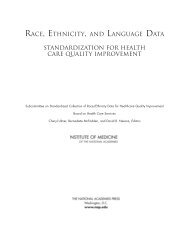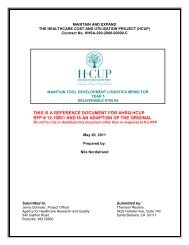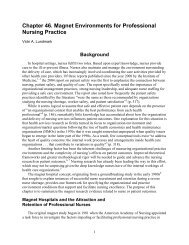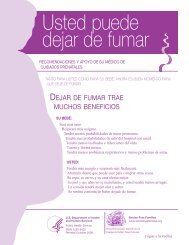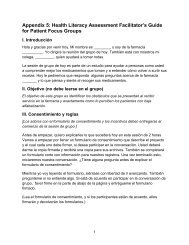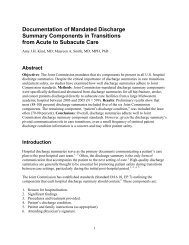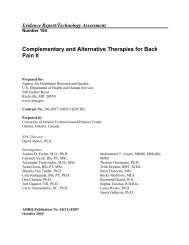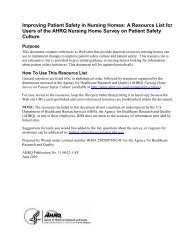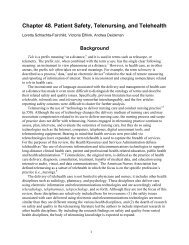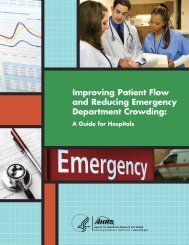Chapter 11. Reducing Functional Decline in Hospitalized Elderly
Chapter 11. Reducing Functional Decline in Hospitalized Elderly
Chapter 11. Reducing Functional Decline in Hospitalized Elderly
Create successful ePaper yourself
Turn your PDF publications into a flip-book with our unique Google optimized e-Paper software.
Patient Safety and Quality: An Evidence-Based Handbook for Nurses<br />
72.9 percent did not walk at all per 3-hour period of observation, 18.6 percent walked once, 5.1<br />
percent twice, and only 3.4 percent walked more than twice. 35 The median time of ambulation<br />
was 5.5 m<strong>in</strong>utes. Of the 32 patients who walked <strong>in</strong> the hallways, 46.8 percent (n = 15) did so<br />
alone, 41 percent (n = 13) walked with a therapist, 41 percent (n = 13) walked with a member of<br />
the nurs<strong>in</strong>g staff, and 18.8 percent (n = 6) walked with a family member.<br />
Based on the results of the CGA, functional problems or potential problems are identified<br />
and specific <strong>in</strong>terventions can be implemented to promote functional ability <strong>in</strong> hospitalized<br />
elders. A number of <strong>in</strong>terventions, <strong>in</strong>clud<strong>in</strong>g structured exercise, progressive resistance strength<br />
tra<strong>in</strong><strong>in</strong>g, and walk<strong>in</strong>g programs, have been implemented to target elder care function<strong>in</strong>g dur<strong>in</strong>g<br />
hospitalization. 35, 37, 38 A randomized control trial of a hospital-based general exercise program<br />
with 300 hospitalized elders that was started dur<strong>in</strong>g hospitalization and cont<strong>in</strong>ued for 1 month<br />
after discharge did not affect length of stay, but did demonstrate better IADL function at 1 month<br />
after discharge. 38 Measures to improve endurance—<strong>in</strong>clud<strong>in</strong>g exercise to enhance orthostatic<br />
stability, daily endurance exercise to ma<strong>in</strong>ta<strong>in</strong> aerobic capacity, or specific resistance exercises to<br />
ma<strong>in</strong>ta<strong>in</strong> musculoskeletal <strong>in</strong>tegrity 17, 39, 40 —need further study on their impact <strong>in</strong> reduc<strong>in</strong>g<br />
functional decl<strong>in</strong>e <strong>in</strong> hospitalized elders. As hospital-based exercise programs require<br />
coord<strong>in</strong>ation and focused implementation plans, strategies for adopt<strong>in</strong>g them need to recognize<br />
the shortened length of hospital stay and the effects of acute illness on the patients’ ability to<br />
participate.<br />
In addition to utiliz<strong>in</strong>g tools to assess the elderly hospitalized patient, assessments of the<br />
hospital culture for provid<strong>in</strong>g elder care can also be beneficial. The Geriatric Institutional<br />
Assessment Profile was specifically developed to assess hospital workers’ knowledge, attitudes,<br />
and perceptions of car<strong>in</strong>g for elders, as well as the adequacy of the <strong>in</strong>stitutional environment to<br />
meet hospitalized elders’ needs. 41 It is recommended to help identify both the strengths <strong>in</strong> elder<br />
care and the opportunities for improvement. 42<br />
Structured Geriatric Care Models<br />
For more than 20 years, the concept of hospital-based geriatric assessment and<br />
<strong>in</strong>terdiscipl<strong>in</strong>ary team care to improve outcomes for hospitalized elders has been implemented <strong>in</strong><br />
various models. Early studies on the use of geriatric evaluation and geriatric evaluation units<br />
demonstrated an impact on reduc<strong>in</strong>g disability and nurs<strong>in</strong>g home placement. 43–45 Several<br />
hospital-based geriatric resource models of care have also demonstrated benefits <strong>in</strong> promot<strong>in</strong>g<br />
evidence-based care for hospitalized elders, <strong>in</strong>clud<strong>in</strong>g the use of geriatric <strong>in</strong>terdiscipl<strong>in</strong>ary team<br />
tra<strong>in</strong><strong>in</strong>g 46 and the use of a geriatric resource nurse. 47 National programs for geriatric<br />
<strong>in</strong>terdiscipl<strong>in</strong>ary team tra<strong>in</strong><strong>in</strong>g were created <strong>in</strong> 1997 to enhance the knowledge of car<strong>in</strong>g for<br />
elders among a variety of health professions. While evaluation data have demonstrated<br />
improvement of geriatric <strong>in</strong>terdiscipl<strong>in</strong>ary team tra<strong>in</strong>ees, most notably <strong>in</strong> attitud<strong>in</strong>al measures, 46<br />
further study on the impact on geriatric care plann<strong>in</strong>g is needed.<br />
Several focused models of care designed to prevent functional decl<strong>in</strong>e of the hospitalized<br />
elderly have demonstrated significant results. The Hospital <strong>Elderly</strong> Life Program, a structured<br />
screen<strong>in</strong>g program for hospitalized patients age 70 years and older, concentrates on admission<br />
screen<strong>in</strong>g of six risk factors: cognitive impairment, sleep deprivation, immobility, dehydration,<br />
vision loss, and hear<strong>in</strong>g impairment. 16 More than 1,500 patients were screened, and targeted<br />
<strong>in</strong>terventions based on the presence of admission risk factors were <strong>in</strong>stituted. Patients were<br />
followed by an <strong>in</strong>terdiscipl<strong>in</strong>ary team that <strong>in</strong>cluded a geriatric nurse specialist, <strong>Elderly</strong> Life<br />
specialists, and geriatricians who worked <strong>in</strong> conjunction with the patient’s primary care nurse to<br />
6



